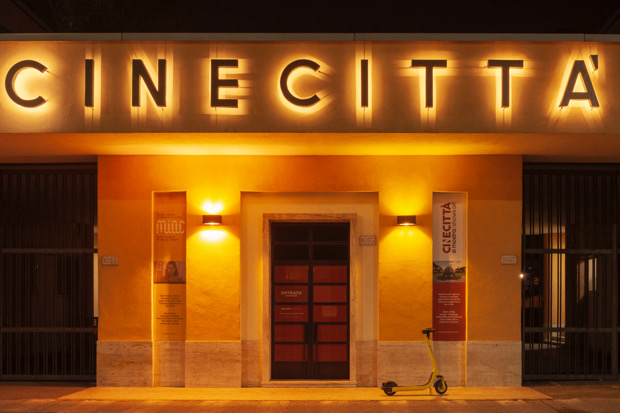Rome’s legendary Cinecitta Studios eye new golden age

A view shows the main entrance of the Cinecitta cinema studios in Rome, Nov. 17, 2021. Image: AFP/Laurent Emmanuel
Once the stomping ground of Italy’s greatest directors and actors, from Federico Fellini to Sophia Loren, Rome’s renowned Cinecitta film studios are planning a much-needed makeover for a new era.
Dubbed the “Hollywood on the Tiber,” Cinecitta was at the heart of the golden age of Italian cinema and now hopes to regain some of its former luster thanks to European Union post-pandemic funding.
Italy is the main beneficiary of the bloc’s recovery fund and the aging studios are in line for a 260-million-euro ($292 million) windfall to expand and modernize to capitalize on the different ways of now watching film and television.
“We can give back to this place the light that has always characterized it, and that it deserves,” Cinecitta CEO Nicola Maccanico told Agence France-Presse, hopefully.
Cinecitta — which means “the city of cinema” in Italian — has been the backdrop of more than 3,000 films, including 51 Oscar winners.
Article continues after this advertisementIn recent decades, although critically acclaimed films such as Bernardo Bertolucci’s 1987 “The Last Emperor” and Anthony Minghella’s “The English Patient” in 1996 were shot at Cinecitta, major productions have become more scarce.
Article continues after this advertisementThe studios were inaugurated on the southern outskirts of the Italian capital in 1937 to churn out propaganda for the Fascist government of Benito Mussolini.
And they have since endured the upheavals of Italy’s modern history: the Allied bombings in 1944, the repurposing of the studios as housing for people displaced by war, the economic “miracle” of the 1950s to 1960s and the subsequent decline.
In its heyday during the golden era of film, major Hollywood blockbusters such as “Ben-Hur” in 1959 and some of world cinema’s most seminal works like Fellini’s 1960 “La Dolce Vita” were filmed at Cinecitta.
But since the end of the 1960s, it has been unable to recapture its former prestige, due to competition from television and major international productions opting for better-equipped studios elsewhere.
‘Unique opportunity’
The studios’ current inability to meet potential demand from TV series and films due to the too-small size of its stages and other deficiencies costs Cinecitta about 25 million euros per year, according to business daily Il Sole 24 Ore.
“For Cinecitta, this is really a unique opportunity because it brings together two situations that are difficult to reproduce: the recovery plan and a booming market,” Maccanico said.
The lion’s share of the money would help double the surface area of the studios, which currently cover about 99 acres (40 hectares), with the creation of five new sets and the renovation and expansion of five others.
Further improvements would include an indoor pool for underwater filming, a theatre with a 360-degree green screen and two sets for virtual reality with LED panels.
Maccanico said that the increased number of platforms for content today had created unprecedented opportunity for film studios.
“It’s within this market context that the idea of re-launching Cinecitta was born… making it a new reference hub for the new European audiovisual production market,” he said.
Film buffs
To boost its income, Cinecitta has held tours for the public since 2011.
Groups of tourists wander the imposing Teatro 5 — Fellini’s favorite and the largest in Europe at 2,880 square meters (31,000 square feet) — or meander amid the white faux-marble, open-air sets of ancient Rome or 15th-century Florence.
A museum with film clips, photographs and costumes is also open to visitors.
A film-themed park associated with the studios also opened on the outskirts of Rome in 2014: Cinecitta World, designed by three-time Oscar-winning set designer Dante Ferretti.
With the likes of studios Pinewood and Shepperton near London, Babelsberg in Germany or Korda near Budapest as rivals, the timing might be right for a renovated Cinecitta.
Italy in 2019 — before COVID-19 shuttered productions worldwide — was the European country with the highest number of domestic productions, at 312 films, ahead of France with 240 and Germany at 237, according to the European Audiovisual Observatory. AP/JB
RELATED STORIES:
Bullet time, augmented reality: The powerful effects of ‘The Matrix’
‘The Matrix Resurrections’ first reactions range from ‘awe-inducing’ to ‘meta to a fault’